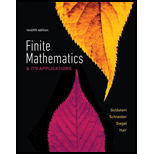
Packaging—-Resource Allocation A computer company has two manufacturing plants, one in Rochester and one in Queens. Packaging a computer in Rochester takes 1.5 hours and costs $15, while packaging a computer in Queens takes 2 hours and costs $30. The profit on each computer manufactured in Rochester is $40, and the profit on each computer manufactured in Queens is $30. The Rochester plant has 80 computers available, and the Queens plant has 120 computers available. If there are 210 hours and $3000 allotted for packaging the computers, how many computers should be packaged at each of the two plants to maximize the company’s profits?
Want to see the full answer?
Check out a sample textbook solution
Chapter 3 Solutions
EBK FINITE MATHEMATICS & ITS APPLICATIO
Additional Math Textbook Solutions
Pathways To Math Literacy (looseleaf)
Intermediate Algebra (13th Edition)
College Algebra (7th Edition)
Probability And Statistical Inference (10th Edition)
APPLIED STAT.IN BUS.+ECONOMICS
- Chatgpt give wrong answer No chatgpt pls will upvotearrow_forward@when ever one Point sets in x are closed a collection of functions which separates Points from closed set will separates Point. 18 (prod) is product topological space then VaeA (xx, Tx) is homeomorphic to sul space of the Product space (Txa, prod). KeA © The Bin Projection map B: Tx XP is continuous and open but heed hot to be closed. A collection (SEA) of continuos function oha topolgical Space X se partes Points from closed sets inx iff the set (v) for KEA and Vopen set in Xx from a base for top on x.arrow_forwardNo chatgpt pls will upvotearrow_forward
- Make M the subject: P=2R(M/√M-R)arrow_forwardExercice 2: Soit & l'ensemble des nombres réels. Partie A Soit g la fonction définie et dérivable sur R telle que, pour tout réel x. g(x) = - 2x ^ 3 + x ^ 2 - 1 1. a) Étudier les variations de la fonction g b) Déterminer les limites de la fonction gen -oo et en +00. 2. Démontrer que l'équation g(x) = 0 admet une unique solution dans R, notée a, et que a appartient à | - 1 ;0|. 3. En déduire le signe de g sur R. Partie B Soit ƒ la fonction définie et dérivable sur R telle que, pour tout réel s. f(x) = (1 + x + x ^ 2 + x ^ 3) * e ^ (- 2x + 1) On note f la fonction dérivée de la fonction ƒ sur R. 1. Démontrer que lim x -> ∞ f(x) = - ∞ 2. a) Démontrer que, pour tout x > 1 1 < x < x ^ 2 < x ^ 3 b) En déduire que, pour x > 1 0 < f(x) < 4x ^ 3 * e ^ (- 2x + 1) c) On admet que, pour tout entier naturel n. lim x -> ∞ x ^ n * e ^ (- x) = 0 Vérifier que, pour tout réel x, 4x ^ 3 * e ^ (- 2x + 1) = e/2 * (2x) ^ 3 * e ^ (-2x) puis montrer que: lim x -> ∞ 4x ^ 3 * e…arrow_forwardshow me pass-to-passarrow_forward

 College Algebra (MindTap Course List)AlgebraISBN:9781305652231Author:R. David Gustafson, Jeff HughesPublisher:Cengage Learning
College Algebra (MindTap Course List)AlgebraISBN:9781305652231Author:R. David Gustafson, Jeff HughesPublisher:Cengage Learning College AlgebraAlgebraISBN:9781305115545Author:James Stewart, Lothar Redlin, Saleem WatsonPublisher:Cengage Learning
College AlgebraAlgebraISBN:9781305115545Author:James Stewart, Lothar Redlin, Saleem WatsonPublisher:Cengage Learning Algebra: Structure And Method, Book 1AlgebraISBN:9780395977224Author:Richard G. Brown, Mary P. Dolciani, Robert H. Sorgenfrey, William L. ColePublisher:McDougal Littell
Algebra: Structure And Method, Book 1AlgebraISBN:9780395977224Author:Richard G. Brown, Mary P. Dolciani, Robert H. Sorgenfrey, William L. ColePublisher:McDougal Littell Elementary AlgebraAlgebraISBN:9780998625713Author:Lynn Marecek, MaryAnne Anthony-SmithPublisher:OpenStax - Rice University
Elementary AlgebraAlgebraISBN:9780998625713Author:Lynn Marecek, MaryAnne Anthony-SmithPublisher:OpenStax - Rice University





